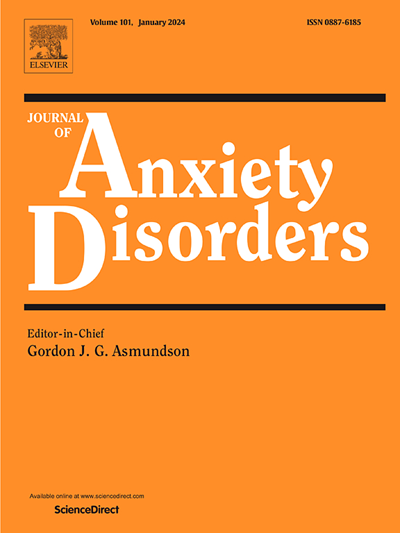Physical activity moderates the relationship between PTSD symptom severity and approach-avoidance conflict decision-making
IF 4.5
2区 医学
Q1 PSYCHIATRY
引用次数: 0
Abstract
Avoidance of potentially dangerous contexts is beneficial for survival (i.e., adaptive avoidance), but the generalization of avoidance behavior to other generally safe contexts (i.e., maladaptive avoidance) can lead to detrimental mental health consequences, including diminished potential for reward. Decisions around pursuing reward in the presence of threat or avoiding threat at the cost of obtaining greater reward presents an approach-avoidance conflict (AAC). Although AAC is expected to be biased among trauma-exposed adults, especially those with posttraumatic stress disorder (PTSD), there have only been two prior behavioral investigations of AAC among adults with PTSD or experiencing PTSD symptoms. While greater levels of physical activity (PA) contribute to enhanced cognitive performance during reward-based decision-making tasks, it remains unknown whether greater PA also offers a protective effect or rather dampens the potential for greater AAC and sacrifice of reward in the presence of threat. The current study administered a trauma-related AAC behavioral task to trauma-exposed adults with varying PTSD symptom severity (N = 93), to examine potential interactive relationships between PTSD symptom severity, PA, and AAC decision-making under threat. The task involved a total of 150 trials and was divided into two phases: congruent (the option with the highest probability of a positive point outcome was also the option that was least likely to result in the presentation of a trauma-related image), and conflict (the option with the highest probability of a positive point outcome was also the option that was most likely to result in the presentation of a threat-related image). Results from linear mixed effects models revealed that PA moderated the relationship between PTSD symptom severity and AAC, as we observed a positive relationship between PTSD symptom severity and AAC for lower PA volume (i.e., greater conflict), and a more negative relationship between PTSD symptom severity and AAC as PA volume increased (i.e., less conflict). These results suggest that greater PA may promote a greater propensity to engage in goal-directed behavior and seek reward in the presence of threat in those with greater PTSD symptom severity.
体育活动调节PTSD症状严重程度与方法回避冲突决策之间的关系
对潜在危险环境的回避有利于生存(即适应性回避),但将回避行为推广到其他一般安全环境(即适应性不良回避)可能导致有害的心理健康后果,包括减少获得奖励的可能性。在存在威胁的情况下追求奖励或以获得更大奖励为代价来避免威胁的决定呈现出一种方法回避冲突(AAC)。尽管AAC在创伤暴露的成年人,特别是创伤后应激障碍(PTSD)患者中存在偏见,但在此之前,只有两项针对创伤后应激障碍或经历创伤后应激障碍症状的成年人的AAC行为调查。虽然在基于奖励的决策任务中,更高水平的身体活动(PA)有助于提高认知表现,但更大的PA是否也提供了保护作用,或者更确切地说,是抑制了在威胁存在时更大的AAC和牺牲奖励的潜力,这一点尚不清楚。本研究对创伤暴露的不同PTSD症状严重程度的成人(N = 93)进行创伤相关的AAC行为任务,以检查PTSD症状严重程度、PA和威胁下AAC决策之间的潜在交互关系。这项任务共涉及150次试验,分为两个阶段:一致性(最有可能得到正面结果的选项也是最不可能导致出现创伤相关图像的选项)和冲突(最有可能得到正面结果的选项也是最有可能导致出现威胁相关图像的选项)。线性混合效应模型的结果显示,PA调节了PTSD症状严重程度与AAC之间的关系,因为我们观察到,当PA容量越小(即冲突越大)时,PTSD症状严重程度与AAC之间呈正相关,而当PA容量越大(即冲突越少)时,PTSD症状严重程度与AAC之间呈负相关。这些结果表明,在PTSD症状严重程度较高的患者中,更大的PA可能会促进更大的倾向于从事目标导向的行为,并在存在威胁的情况下寻求奖励。
本文章由计算机程序翻译,如有差异,请以英文原文为准。
求助全文
约1分钟内获得全文
求助全文
来源期刊

Journal of Anxiety Disorders
Multiple-
CiteScore
16.60
自引率
2.90%
发文量
95
期刊介绍:
The Journal of Anxiety Disorders is an interdisciplinary journal that publishes research papers on all aspects of anxiety disorders for individuals of all age groups, including children, adolescents, adults, and the elderly. Manuscripts that focus on disorders previously classified as anxiety disorders such as obsessive-compulsive disorder and posttraumatic stress disorder, as well as the new category of illness anxiety disorder, are also within the scope of the journal. The research areas of focus include traditional, behavioral, cognitive, and biological assessment; diagnosis and classification; psychosocial and psychopharmacological treatment; genetics; epidemiology; and prevention. The journal welcomes theoretical and review articles that significantly contribute to current knowledge in the field. It is abstracted and indexed in various databases such as Elsevier, BIOBASE, PubMed/Medline, PsycINFO, BIOSIS Citation Index, BRS Data, Current Contents - Social & Behavioral Sciences, Pascal Francis, Scopus, and Google Scholar.
 求助内容:
求助内容: 应助结果提醒方式:
应助结果提醒方式:


